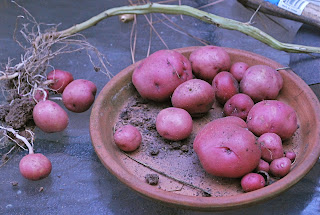 While reading Julia Child's My Life in France, as well as other books by and about chefs, I am always a bit envious of the chef's ability to create recipes. After a little more thought on the matter, I've decided we all create recipes without realizing it. How many of us tweak a recipe here and there or make substitutions out of necessity or "what if..."? I catch myself doing it all the time.
While reading Julia Child's My Life in France, as well as other books by and about chefs, I am always a bit envious of the chef's ability to create recipes. After a little more thought on the matter, I've decided we all create recipes without realizing it. How many of us tweak a recipe here and there or make substitutions out of necessity or "what if..."? I catch myself doing it all the time.This recipe is just such a bit of creative cookery, inspired by Moroccan tangine, though I don't think any Moroccan would really approve, but it is delicious!
Tagine with Butternut Squash
(served on a bed of whole wheat Green onion couscous–recipe follows)
2 teaspoons smoked paprika
1 teaspoon ground cinnamon
1/2 teaspoon Kosher salt
1/4 teaspoon crushed red pepper
1/4 teaspoon cayenne pepper
1 (1-lb.) pork shoulder cut into 1" cubes
1 Tablespoon olive oil

1/2 red onion, coarsely chopped
4 garlic cloves, chopped
1/2 cup stock (I used my own veggie stock)
1 (14.5 ounce) can Muir Glen fire-roasted tomatoes, undrained
3 cups peeled butternut squash cut into 1" cubes
(fresh from the garden–how lucky am I)
1/4 cup chopped fresh cilantro (optional, since I completely forgot, and it was still delicious!)
1. Combine spices in a bowl. Add pork and toss well to coat. Let rest for about 20 minutes.
2. Heat oil in Dutch oven over medium-high heat; cook about 5 minutes or until browned, stirring occasionally. Add garlic and cook another minute; stir frequently.

3. Stir in broth and tomatoes; bring to a boil. Cook 5 minutes. Add squash; cover, reduce heat and simmer 30 minutes or until squash is tender.
Note: or should I say 'notes'? First, the original recipe called for beef, but I really enjoy the pork with the other flavors. I would also like to try this with lamb, one of my favorite meats.
Also, this may be a good time to start the couscous if you're using whole wheat, which uses 20 minutes of resting time.
My last note has to do with an alternate mode of cooking. I made this for a crowd of 12, tripling the ingredients and letting it cook in a crock pot the day before I was to serve. This did two things: first, it cooked it slowly, which is how I think tagine should be cooked; and second, it allowed the flavors to marry overnight, making it more flavorful. But, if you only have an hour, this will still delight your palate!
4. Serve on a bed of green onion couscous and sprinkle with cilantro. I also served with potato rolls and butter; yum!
Bon appetit!
Oh, yes, and here's the recipe for the couscous:
Green Onion Couscous
Bring 1 cup stock and 1/2 cup water to boil in a medium saucepan (or use all stock, if you like). Gradually stir in 1 cup uncooked whole wheat couscous. Remove from heat and let stand 20 minutes. If you're using regular couscous, you'll need only 1-1/4 cup of liquid and five minutes standing time. Fluff couscous with a fork and stir in 1/3 cup of chopped green onion, including the green portion. This, and the tagine as written, will serve four.









































